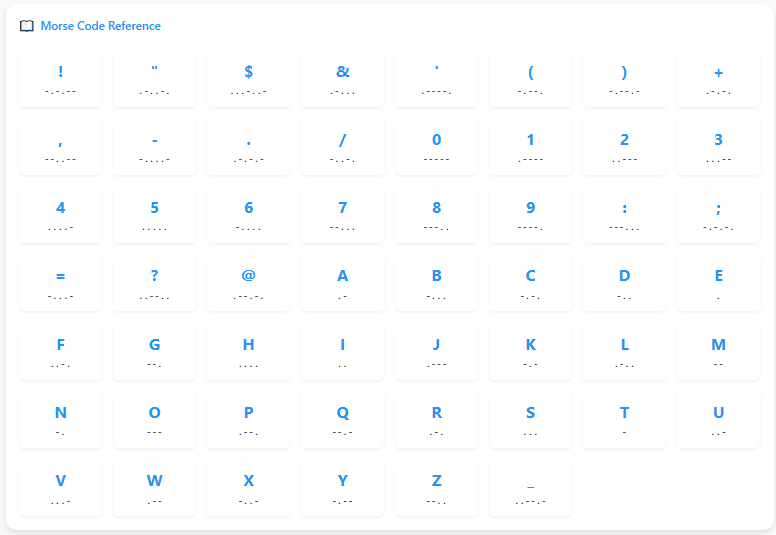
Learn the complete Morse code alphabet (A–Z) and numbers (0–9), each represented by a distinct combination of dots and dashes
Morse code is a method of transmitting text information as a series of two signal durations: dots (short signals) and dashes (long signals). Developed by Samuel Morse and Alfred Vail in the 1830s, it was initially designed for use with the telegraph system to send messages over long distances. Learn Morse Code by learning Morse Code Alphabets.
Each letter, number, and some punctuation marks have a unique Morse representation. Here are a few examples:
A = ·−
B = −···
C = −·−·
1 = ·−−−−
0 = −−−−−
Morse code can be sent using sound, light, visual symbols, or physical taps, making it extremely versatile. It’s still widely used today in aviation, ham radio, and by emergency responders.
Before learning Morse code, you need to understand its structure:
Dot (·): short signal
Dash (−): long signal (3x length of a dot)
Space between dots/dashes: very short pause
Space between characters: pause equal to 3 dots
Space between words: pause equal to 7 dots
Here’s the full Morse alphabet for letters and numbers:
| Character | Morse Code | Character | Morse Code | |
|---|---|---|---|---|
| A | ·− | N | −· | |
| B | −··· | O | −−− | |
| C | −·−· | P | ·−−· | |
| D | −·· | Q | −−·− | |
| E | · | R | ·−· | |
| F | ··−· | S | ··· | |
| G | −−· | T | − | |
| H | ···· | U | ··− | |
| I | ·· | V | ···− | |
| J | ·−−− | W | ·−− | |
| K | −·− | X | −··− | |
| L | ·−·· | Y | −·−− | |
| M | −− | Z | −−·· |
| Number | Morse Code |
|---|---|
| 1 | ·−−−− |
| 2 | ··−−− |
| 3 | ···−− |
| 4 | ····− |
| 5 | ····· |
| 6 | −···· |
| 7 | −−··· |
| 8 | −−−·· |
| 9 | −−−−· |
| 0 | −−−−− |
Here’s a comprehensive breakdown to help you learn Morse code effectively.
Focus on high-frequency letters in English first, such as:
E (·)
T (−)
A (·−)
O (−−−)
I (··)
N (−·)
These form the basis of many common words and phrases. Mastering them early builds confidence.
The Farnsworth Method teaches Morse code at full character speed, but with longer pauses between characters and words. This helps train your brain to recognize letters as whole sounds, rather than counting dots and dashes.
You must recognize Morse code by sound, not just by sight. Listening helps you:
Build speed
Improve decoding
Prepare for real-world communication (e.g., ham radio)
Start with 5 WPM (words per minute) and gradually increase as you get comfortable.
Great Tools for Listening Practice:
LCWO.net (Learn CW Online)
Morse Code Ninja (YouTube & app)
Ham Morse
CWops Training
Once you can hear and understand Morse code, learn to transmit it using:
Flashlights (light signals)
Sound (beeping apps or keyers)
Vibrations (e.g., on a phone)
Taps (on a desk or using fingers)
Use real tools like:
Straight key or paddle key
Morse practice apps
Try tapping out simple words like “HELLO” or “SOS”.
Translation exercises help reinforce your learning. Start with simple words:
CAT = −·−· ·− −
HELP = ···· · ·−·· ·−−·
Gradually move on to full sentences and common phrases.
Make your own flashcards or use apps like:
Anki
Quizlet
Morse Mania
These help build muscle memory and long-term retention.
Connect with others for feedback and motivation. Try:
Reddit’s r/morsecode
Discord communities
Ham radio clubs (ARRL)
Online CW contests
Practicing with others boosts speed and confidence.
| Type | Tool/App/Website | Description |
|---|---|---|
| Website | LCWO.net | Full Morse learning with audio lessons |
| App | Morse Code Ninja | Audio drills at multiple speeds |
| Flashcard App | Anki / Quizlet | Spaced repetition memory training |
| Translator | TexttoMorseCode.com | Convert text to Morse & vice versa |
| Games | Morse Mania | Fun Morse code quizzes and challenges |
| YouTube | Ham Radio Crash Course | Beginner-friendly CW guides |
Learning Morse code is a powerful and rewarding experience. It connects you with history, empowers you in emergencies, sharpens your brain, and opens the door to new hobbies like amateur radio.
© 2024 Crivva - Business Promotion. All rights reserved.